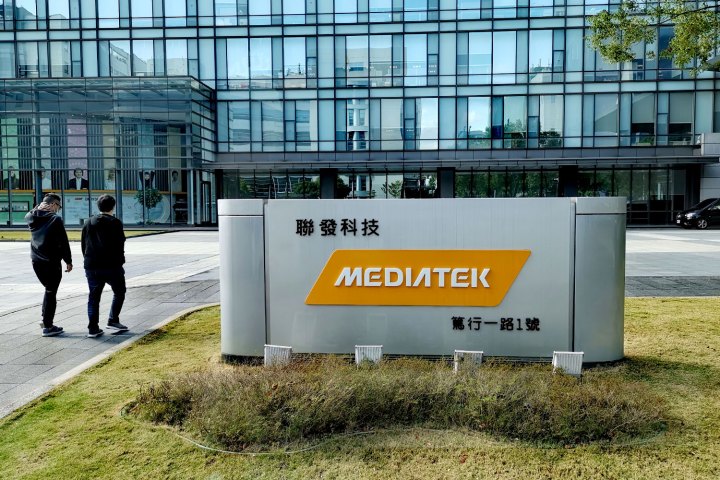
MediaTek firmly believes the demand for 5G smartphones will begin in earnest during 2020, particularly for less expensive models, and following the announcement of its flagship Dimensity 1000 5G processor for phones, it has now come along with the Dimensity 800, a midrange chip. Except, MediaTek needs a new dictionary because it’s not very midrange at all.
The Dimensity 800 is a competitor to the Qualcomm Snapdragon 700 series, says MediaTek; but it has blurred the line between its flagship, high-end Dimensity 1000 processor and the mid-range chip so much, it’s difficult to separate them.
“We believe the 5G experience should be available by the mass market,” MediaTek’s Senior Product Manager Wendy Su told Digital Trends in an interview. “We launched the Dimensity 1000 at the end of November. Now the Dimensity 800 brings the same user experience to the midrange. It uses a 7nm process, and it continues the advanced CPU and A.I. architecture, plus we kept a lot of the camera capabilities too. It’s exciting for us.”
High-end specs
The new octa-core system-on-a-chip uses four ARM Cortex A76 cores running at 2GHz, and four Cortex A55 cores running at the same speed and is the first to bring this setup to mainstream 5G smartphones.
“This usually only exists in chips like the Huawei Kirin 990 and the Snapdragon 800 Series,” Erwin Wang, MediaTek’s Product Marketing Manager continued. These processors are found in the high-end 5G phones available today, including the Huawei Mate 30 Pro and the Samsung Galaxy S10 5G.
“Mediatek brings this technology not just to the Dimensity 1000, but also the mid-tier 800. We don’t want to sacrifice the end user experience even though it’s not a flagship chip,” he said.
Despite being positioned against the 700 series, Mediatek says the Dimensity 800’s performance is greater than some Snapdragon 800 chips by about 15%. It has the same image signal processor and A.I. camera as the 1000 series chip, it supports features like HDR for video for example, which is more often found on high-level chips.
What else? It supports high-resolution screens with a 90Hz refresh rate, cameras with up to 64-megapixel sensors, and all the artificial intelligence features from the Dimensity 1000 chip too. These include A.I. autofocus, noise reduction, face detection, and multi-frame 4K HDR video, too. It does this by using the same A.I processing unit as the Dimensity 1000, plus the GPU’s computing power is also exactly the same as the flagship chip too.
See what we mean about not quite understanding the definition of midrange?
Mass market appeal, and price
The Dimensity 800 chip embodies MediaTek’s ‘New Premium’ approach to its products, which it defines as offering high-end features for a midrange price. But what does this really mean? 5G connectivity adds cost to a smartphone, so how can a 5G phone remain accessible once the technology is inside, and is there really demand for such a device at the moment, given our ability to find a 5G signal is still quite low.
“We’re positioning this for midrange phones. It’s affordable,” Wendy Su reconfirmed. “Phones with the Dimensity 800 will be priced at a point that the mass market is willing to pay.”
Which is what, exactly? MediaTek has been working closely with its carrier and device manufacturer partners to ensure it comes in at the right price.
“Many people are waiting for a 5G smartphone, and will pay more,” Wang told us. “But we also know the price difference should not be so big between 4G and 5G phones. Research from the main operators in China shows people are willing to pay between 300RMB and 500RMB more for a 5G phone. This is about $80.”
Global launch
5G in China has only recently launched, but the competition there is very strong. While MediaTek’s chips will be used in 5G phones sold in China, they will also be used in phones sold around the world. Although the Dimensity 800 operates as a sub-6GHz 5G chip, MediaTek is not ignoring mmWave, the 5G connection primarily being pushed in the U.S. Owen explained its partners are focused on sub-6GHz for now, but its R&D department is working on a mmWave 5G solution.
“You will see our mmWave 5G solution in the near future. It will come soon,” he told us.
The Dimensity 800 system-on-a-chip and the phones it will go on to power, are designed for use in Asia, Europe, and North America, and the first Dimensity 800 smartphone model will be released in the second quarter of 2020.
“5G is a new era,” Wang emphasized, “and it’s important for Mediatek.”
This echoes the words of the company’s CEO Rick Tsai when he outlined the 2020 plan for the Dimensity series to Digital Trends recently. The Dimensity 800 is the second chip in the new Dimensity family, and there is still a third, more basic version to come. Based on the 800’s high specification, we doubt MediaTek will have checked the dictionary about what a low-end processor specification should be by then either.
Follow our live blog for more CES news and announcements.



